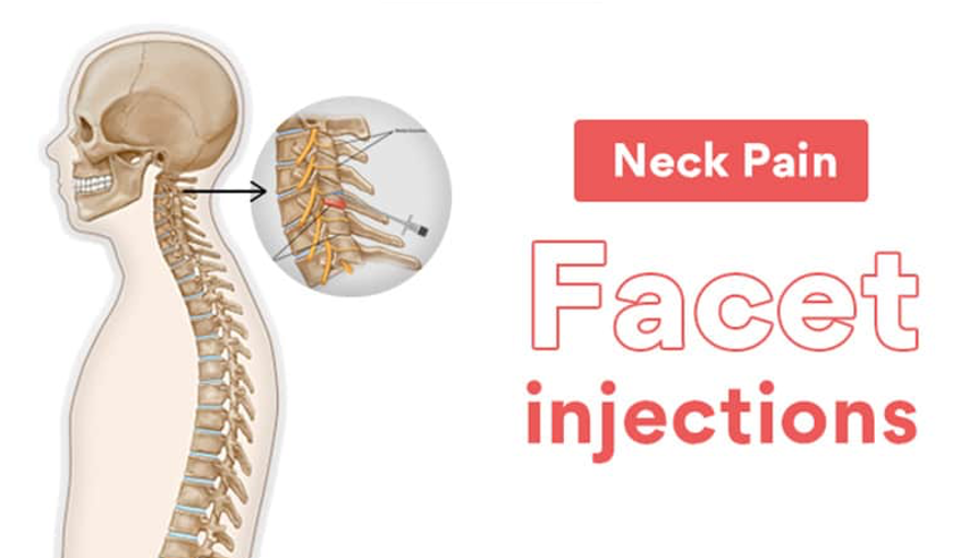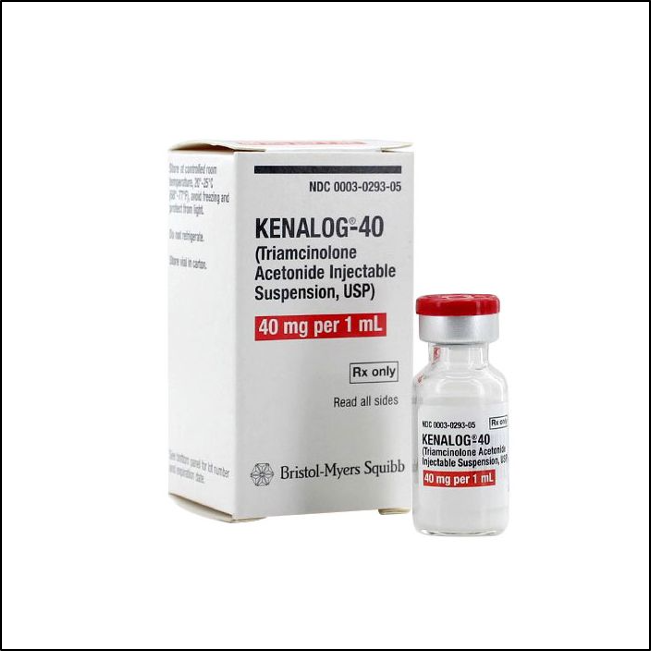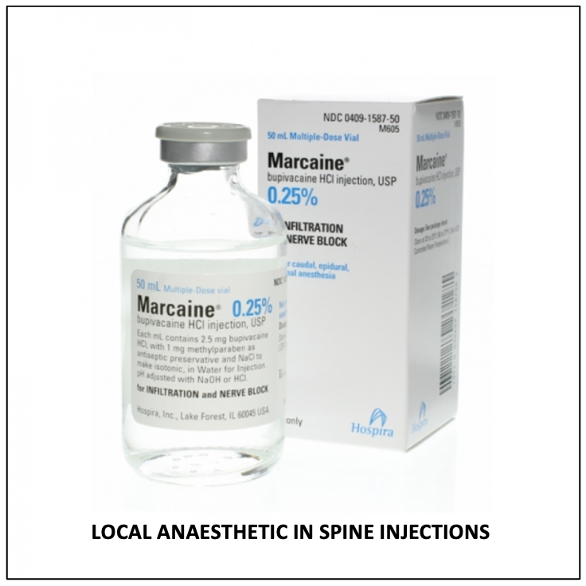Facet joint injection is recommended for control of your severe neck pain. Inflammation caused by the wear and tear of your spine produces chemicals around your small joints of your spine called the ‘facet joint’.

Facet steroid injection acts on these chemicals to improve pain and stiffness in your neck. If these symptoms worsen, you will need to seek urgent consultation.
What are Facet joints of the Neck?

1) Facet joints in the neck are the small joints that connect the bones of the spine in your neck.
2) There are two facet joints on either side as shown in the diagram (arrows)
3) These joints are lined by cartilage and covered by ligament and muscles of your neck.
4) These facet joints give structural stability to your neck.
5) Along with the disc, these facet joints on either side carry the weight of your head.

1) Facet joints of the neck linking the bones of the spine in your neck as shown in the diagram (arrows).
2) As your age advances, wear and tear changes occur in these facet joints.
3) Wear and tear changes cause inflammation, pain, stiffness and reduced movement in facet joints.
4) Facet joints injections are steroid injections that can offer instant relief from your neck pain and stiffness.
5) Steroid injections can also help with the movements of your neck and this reduces neck and arm pain over a long period of time.
What are the symptoms of facet joint problems?
Pain and stiffness of the neck are the common symptoms due to inflammation of the facet joints from ‘wear and tear’. The wear and tear from age leads to osteoarthritis of these joints. All these symptoms are know as “facet joint syndrome.”
The pain and stiffness in the neck is worse after prolonged periods of inactivity. Poor posture of the neck during work and lack of movement of the from regular breaks can cause the facet joints to become inflamed. Changing positions often and loosening your neck frequently improves facet joint pain.
What are the treatment options for facet joint pain?
Facet joint injections:
Targeted steroid injections given into a specific facet joint to treat neck pain.
Medial branch blocks:
Targeted nerve block injections with a local anaesthetic to block the medial branches (pain transmitting branches) of spinal nerves that supply the facet joint.
Radiofrequency ablation (RFA):
Procedure done under sedation to burn off the nerves that cause pain from the inflamed facet joint.
Where are Facet joint steroid injections given in the neck?
Facet joint steroid injections are given on both sides over and inside the facet joint as shown by the arrows in the picture. There are two facet joints on either side and both sides will have the injection if they are painful. Steroid injections inside the joint are given so accurately with the use of Xrays as there are very important structures in your neck. Xrays increases the safety of the procedure and gives very good results and outcome.
What does a Facet joint steroid injection for the neck contain?
Facet Joint injection contains a mixture of:
- Kenalog 40 mgs (Steroid)
- Marcaine 0.25% (Local anaesthetic)
-

Kenalog is a Steroid commonly used in Facet joint Injections. This steroid works on the small joints of your spine called ‘facet joints’ and reduces pain and inflammation around them.
It blocks the chemicals that your body releases with the inflammation around the facet joints due to arthritis. Due to the pain relief, there is more movement in the small (facet) joints and the soft tissues.
This increase in movement will further reduce the stiffness around the bones, ligaments and muscles of your spine.

Marcaine 0.25% is a local anaesthetic (numbing solution) used by your dentist. This is also used in Facet joint Injections. This solution works on the small joints of your spine called ‘facet joints’ and reduces pain and works very well with the steroid.
It blocks the pain signals released by your irritated and inflamed facet joints and the steroid works to control the inflammation. Due to the pain relief, there is more movement in the small (facet) joints and the soft tissues.
This increase in movement will further reduce the stiffness around the bones, ligaments and muscles of your spine.
What does facet joint steroid injection do?
Facet joint injection contains a mixture of numbing solution (local anaesthetic) and corticosteroid (steroid). The local anaesthetic will improve the pain immediately and the steroid in the solution will act on the inflammation around the covering (capsule) of the facet joints and control the pain in the long term. This improvement in the pain will help you move around better and mobilise your neck. This increase in the movement of the small joints of your spine will further reduce the stiffness around the bones, ligaments and muscles.
What happens during the facet joint steroid injection procedure?
Day Case Procedure:

This procedure is done as a Day Surgery procedure. You will need to come in starved for at least 6 hours and will be at the hospital for less than a day. You will be given a sedative by the anaesthetist so that you do not feel the pain or the procedure.
The facet joint steroid injection procedure takes less than 10 minutes and is very safe.
Procedure is done under X-ray:

X-rays will be taken (shown in picture) to make sure that the needle placement is accurate. The dye (Omnipaque 300) is not used before the anaesthetic and steroid solution is injected. You will recover from the procedure and sedation very quickly. A spinal needle is used to inject the steroid and anaesthetic solution in and around the ‘facet joint’.
After the injection, you will be taken to the recovery room from theatre and monitored for an hour. You will be able to leave hospital once you are safe.
What happens after the Facet joint injection?

After the injection, you will be taken to the recovery room from theatre and monitored for an hour. You will be able to leave hospital once you are safe. You must continue to take your usual pain relief medication that your doctor had prescribed for you till you begin to feel benefit.
Some medications like morphine, gabapentin, pregabalin or amitriptyline need to be continued and not stopped abruptly.
What are the benefits of Facet steroid joint injection for the neck?
8 out of 10 patients will have significant benefits from these facet joint injections. But the duration of this pain control varies between a few weeks to a few months. Sometimes the pain relief can last for a year. For most part, these facet joint injections can provide excellent pain relief enabling you to continue with physiotherapy rehabilitation. Occasionally, you run the risk of getting the pain in your neck sooner than expected.
Repeat Injections: If the initial facet joint injection was helpful in controlling your neck pain, you will be offered a repeat injection. Most specialists would wait at least six months before repeating them.
How many Facet steroid joint injection can you have?
Most experts recommend not more than 3 injection over a 12-month period. There are concerns about the adverse side effects of repeated steroid injections on your spinal cord, nervous system function and on your metabolism. There is a very small risk of diabetes, raised blood pressure, decreased immunity, recurrent infections and weight gain.
What are the risks and complications of Facet joint injections?
Infection:
This is rare but there is an increased risk in skin conditions like psoriasis or eczema.
Bleeding:
There is very little chance that you will bleed from a tiny puncture wound with a needle. But there is an increased risk of bleeding if you are taking medications to ‘thin your blood’ like warfarin, rivaroxaban or clopidogrel. You will be advised to stop these medications at least a week in advance of the procedure for safety.
Fascial Flushing:
This is a temporary side effect from the steroid injection and settles down very quickly.
Rise in Blood Sugar:
In people with diabetes or at risk of diabetes, their blood sugar is found to rise immediately after the caudal epidural injection. This will settle after a few days without treatment.
When can you get back to work after Facet joint steroid injections of the neck?
Facet joint steroid injections are simple, non-invasive, safe procedure that provides instant relief from neck pain and stiffness. However the results vary between patients and last anywhere between six weeks to 6 months. It is the physiotherapy exercise program that gives the maximum benefit from this injections.
These steroid injections just provide the pain relief necessary for the physiotherapy program to improve the movement and function of the facet joints
Therefore the success of the facet joint steroid injection depends on the physiotherapy program that follows after the injection.
How successful are Facet joint steroid injections of the neck?
You are advised to take the next day off work as you had an intravenous sedation. If your neck pain persists or is worse, you may need a few days off work. Usually, it can take several weeks before you feel the full benefit of the facet joint injection. There are no limitations for work if your pain settles after a day.
How painful are Facet joint steroid injections of the neck?
The actual procedure of a facet joint injection is not painful as it is done under sedation and it takes just 10 minutes for the actual procedure to be done. You will wake up with no pain and will be sent home with medications to control any pain after the local anaesthetic wears off.
Can you drive after Facet joint injection?
Avoid driving for at least 12 hours after the procedure. You may suffer from dizziness or sickness as you may not have fully recovered from the sedation. It is common to experience mild soreness at the site of the steroid injections for 24–48 hours.
Your neck may feel stiff and sudden movements or jerks can cause severe pain. So, driving may be a risk if done early.
What happens after the Facet joint injection?
The effect of facet joint steroid injection lasts between 6 weeks to 6 months. There is an instant pain relief from the local anaesthetic which lasts for a few hours. The cortisone (steroid) starts to work in 24 to 48 hours and last for a good few months.
In some patients they seem to last for ever. Some need a few more injections for good relief from facet joint pain.
What happens if the Facet joint injections don’t work?
Facet joint steroid injections are successful on most occasions. However in some instances, you may need up to 2 or three sets of these injections. If this treatment with facet joint steroid injections are unsuccessful, radiofrequency ablation will be recommended.
Radiofrequency ablation is a procedure where radio waves are used to generate heat to burn off the tiny nerves that supply the facet joints. By burning of these nerves, the pain sensation from these joints can be blocked and this can lead to permanent freedom from pain.
